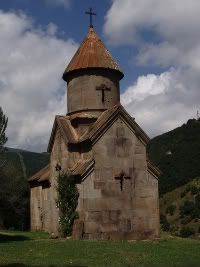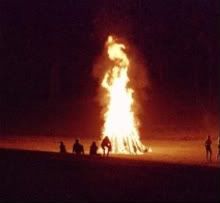Twelfth Night
Twelfth night is celebrated 12 days after Christmas. The celebration commences with the choosing of a king and queen. This is done by distributing two cakes. One to females and one to males. Inside each cake is a bean or bead the male and female who have this item in their piece of cake become the king and queen of the twelfth night celebrations.

Secondly, a feast is held. According to ostgardor the feasts is similar to this: On the tables: Bread Butter Cheese First serving:
Fish Fungus in pastry
Syrosye (bread crumb, sugar and cherry paste)
Second serving:
Pullets (poultry) roasted with cold sage
Rice endored (saffron rice)
Salad
Third serving:
Venison sausages with compot (sauce)
Green porray (green leafy vegetables)
Sambocarde (cream and elder flower pie)
After the feast everyone toasted to the trees. This was done by either going outside and standing around the oldest tree or having a real or artificial tree brought inside. People would toast the tree/s with a cup of cider and three pieces of seed cake. After eating one piece of cake and offing the remaining to the tree, they would circle the tree and sing. After this the would pour the remaining cider on the tree roots and return to festivities. Mumming is also an important tradition on twelfth night. local peasants and nobles and travelling professionals, alike, would perform plays and skits. An example of this is the Hobby Horse, where a performer mimicked a mounted knight. To conclude the event all of the candles lighting the room were doused and a single light, which may have been a candle on a pole or lamp on a pulley, would appear. Three actors would follow the candle and act out the scene of the three wise men following the star of Bethlehem.
St Valentine’s Day
The celebration of st Valentine’s Day differs, but the underlying meaning was always the same, love. People wore symbols of love around their necks such as lover’s knots or hearts.
The day was celebrated by decorating the hall with candles in hollowed out vegetables. The guest’s names, which were equal between male and female, were placed in separate dishes and members of the opposite gender pulled out a name each. These couples were to be sweethearts for the year. After the couples were seated together around the table a feast was served. This included heart shaped cakes.
After the feast some games were played, these included passing around yarrow sprigs. If one received a healthy sprig they would be granted eternal love, if it were a wilted sprig it was said that they would never find true love. Another game is leaving a yarrow sprig that has been sprinkled with rosewater one your pillow overnight. If it was still healthy in the morning then it meant eternal love.
Easter
The preparations for Easter began on Ash Wednesday when ashes were spread on all who attended church. This marked the beginning of six weeks of abstinence and fasting for all people, including the nobles. Eggs laid during this time were hardboiled to preserve them for use on Easter.
On the day of Easter many people would get up early to watch the sun rise. Many members of the parish would stand by the church and sing hymns to welcome the sunlight. For people who could afford it, they would wear a new item or set of clothes to church.

A medieval church
For children, parents would hide hardboiled eggs for the children to hunt for. This game symbolises the apostles finding Jesus missing from his tomb. Other games were played too. These included egg rolling and parades. Easter was one of the very few days when no one had to work. It was tradition for the servants to present their lords with a small gift and in return the lord would hold a feast for all of the members of the house, including the servants.
May day
May day is a tradition that out dates Christianity and was widely celebrated well before medieval times. May day is celebrated to signify the end of winter, which means better times are soon to come.
The festivities would start on May Day eve, where there was a big bon fire, dancing, feasting and storytelling. On the morning of each May Day, young men and women would go into the forest to collect wood and flowers for the celebrations later on in the day. Villages would compete to see who could bring bake the largest piece of wood, this would be used as the maypole. A May Day queen would be chosen from all of the young single women, often by a man who had won a tournament. She would be crowned with flowers and paraded around the village. Flowers, trees, and animals, as a sign of growth and new life, were a consistent theme of May Day. Many young men would give the girl that they liked a small tree decorated with streamers, though if the streamers were white it was a sign of hatred for the girl.
Toward the end of the day there was a feast and men performed dances, often in animal costumes.
All Hallow’s Eve/ Samhain
Note: samhain means the end of summer in Gaelic. It can be pronounced many ways such as 'sow-in' (in Ireland), or 'sow-een' (in Wales), or 'sav-en' (in Scotland), or 'sam-hane' (in the U.S where Gaelic is not a commonly spoken language). Although all hallows is derived from the Christian view of this celebration where they refused to celebrate all of the dead, only those who where blessed or hallowed.
This is exactly opposite to May Day on the wheel of the year (medieval calendar system) and therefore the opposite to this bright and happy occasion. All hallow’s eve (followed by the less important all hallow’s day) celebrates and honours the dead. On all hallow’s eve a large gathering would be held. The hall would have a small bonfire or a large candelabra (many candles arranged together) in the center of the room.

A bonfire
A feast was held with man apple dished served. This is because apples were the main theme for the celebration. Games would be played such as apple bobbing and peeling an apple in a spiral and throwing it over the left shoulder, it is said that it would land in the shape of your true love’s initials. It was also a tradition to sleep with an apple beneath your pillow, you would dream of your true lover, then getup and sit outside to eat the apple before the sun rose. If you became cold your desire for this person would not be granted.
Christmas Christmas
celebrations begin at Christmas Eve and ends on the twelfth night. This is because the number 12 is associated with Christmas, for example there are twelve candles, twelve kisses or gifts exchanged under the mistletoe, twelve wassailings (simmilar to caroling, done to wake the apple cider tree and scare evil spirits), twelve courses of the feast, and twelve sprigs of holly per bunch.
One popular tradition is the Yule log; this is an extremely large log that can be burned for the entire 12 days. The Yule log is decorated and carved before it is burnt. At the Christmas feast 12 wassailings are performed around the hall by singers and musicians. This is done while holding a box containing gifts as offerings. At the feast mince pies would be eaten, these were made out of meat (commonly venison) fruit and spices. Also, for those who could afford it goose was eaten. Christmas was an extremely religious event with all Christians attending church on Christmas Eve and day.
Bibliography:
- Castles, July 20 2005, 4-9-08, http://www.castles.me.uk/copyright.htm Mostly medieval, 1998, Wallace.S, 28-8-08, http://mostly-medieval.com/explore/jan.htm
- Østgarðr, 2000, society for creative anachronism, 30-8-08, http://www.ostgardr.org/
- Suite 101, 21-4-08, Bellerby.R, 2-9-08, http://medievalhistory.suite101.com/article.cfm/may_day_in_medieval_time.
- Transmutations, 2005, Minimus. R, 3-9-08, http://transmutations.blogspot.com/ by Lauren McDonald
No comments:
Post a Comment